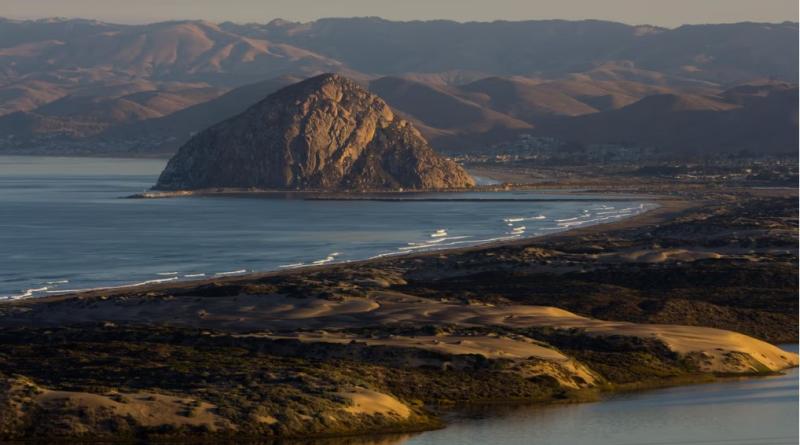‘We felt so betrayed’: Indigenous tribe reels after exclusion from US marine sanctuary

The Chumash tribe had advocated for California’s central coast to be protected, but a draft management plan left out the stretch they had hoped would be protected
Violet Sage Walker stands on the bow of Greenpeace’s Arctic Sunrise ship and looks out at Morro Rock jutting up from the Pacific Ocean. The dramatic promontory – known as Lisamu’ in Chumash, the language of Walker’s tribe – is part of a stunning stretch of California coastline she hoped would soon be part of a sprawling new marine sanctuary six times the size of Yosemite.
Walker is the chairwoman of the Northern Chumash Tribal Council, a small group of Indigenous Americans who once lived along the coast of San Luis Obispo county. Records of their occupation of the central coast date back to 18,000 years.
The tribe has been tirelessly campaigning for the central coast to be designated as a marine sanctuary – a fight Walker’s father, Fred Collins, started more than five decades ago – and was confident the sanctuary would go ahead after a successful public comment period last year drew 10,000 supporting signatures.
But then, last month, the National Oceanic and Atmospheric Administration (Noaa) released a draft management plan for the sanctuary that left the tribe reeling. The stretch of coast they had advocated for – from Cambria to Morro Bay – had been left out. Instead, Noaa’s proposed sanctuary would start just south of Morro Bay, stretching down to Gaviota. The reason, Noaa told the Guardian, is because a marine sanctuary is not compatible with offshore wind – and Morro Bay is set to be the hub of the country’s biggest offshore wind development project.
“We felt so betrayed,” says Walker. “We really thought we were going to get the marine sanctuary we had campaigned for, we thought we were going to get protection for the entire central Californian coastline.”
Walker is traveling from Long Beach to Morro Bay onboard the Arctic Sunrise in an attempt to raise awareness of what is at stake if this area is not protected. She’s hitching a ride with the 16-strong international Greenpeace crew. After dinner, most of the crew gather in the ship’s mess to hear the struggles of Indigenous people to safeguard the land – as well as the tribe’s creation story, which springs from the idyllic Channel Islands, whose sheer cliffs and rugged mountains the ship sails past on its way to Morro Bay.
The mood onboard is somber but electric; everyone is here with the same goal: to protect the ocean from offshore wind, oil drilling and deep sea mining. Members of the crew nod their heads in understanding as Walker recounts the tribe’s fight against government agencies, big corporations and power-driven politicians. The tribe has less than a month to encourage people to speak out and sway Noaa’s decision on the size of the sanctuary and how it is managed, before the government agency’s public comment period officially closes on 25 October.
“I need to know, in 60 days’ time when this last round of public comments is over, that I’ve done everything I possibly could have done to make this sanctuary happen,” Walker says.
One of the tribe’s driving factors for establishing the sanctuary is to protect the area from the offshore windfarms slated to be built along the coast. Morro Bay, an area of rich biodiversity – including part of the country’s last remaining population of endangered sea otters – would become a hub for offshore wind if the sanctuary’s boundaries do not extend to include it.
Walker is hoping the Greenpeace trip will help alert the public about the impact that this development would have on the coast – and urge people to make a public comment to ensure windfarm developers are held to stricter environmental regulations. Leaving out the Morro Bay to Cambria stretch also means the area can be exploited for oil drilling and deep sea mining.
“Indigenous people are the traditional caretakers of these waters and these lands,” says Arlo Hemphill, who leads the ocean sanctuary and deep sea mining campaigns for Greenpeace’s US office. “And so working with them was a natural move for us. There’s also the moral imperative on top of conservation – from a justice standpoint, it’s important to return these waters to the stewardship of Indigenous people.”
The sanctuary proposal had already made history for being the US’s first ever tribally nominated sanctuary. It would also be the largest marine sanctuary in the country, and the only one to be co-managed by a tribe – that is, if Noaa adopts the original sanctuary boundaries proposed by the tribe, rather than the amended version the agency has published.
The proposed windfarm that concerns the tribe would be the largest in the country, with 380 floating windmills across roughly 250,000 acres. The turbines could eventually power 1.6m homes and will be key in California’s transition to clean energy. The farms, however, would require underground cabling to a centralized base at the shore in order to dispatch the energy. It is unknown how the turbines and cabling will affect migratory patterns of whales and other species, but Noaa has highlighted the developments could increase ocean noise, change existing habitats, affect life cycles of fish, change species survival rates, and release contaminants that could be absorbed by marine life.
When asked why Morro Bay was not included in the proposed sanctuary boundaries, Paul Michel, the regional policy coordinator of Noaa sanctuaries west coast region, said the agency “did not hear compelling comments” for why the region needs protection from offshore windfarm developments. He added that the bay already has some protections under a National Estuary Program, but that only encompasses around 3.5sq miles of shallow marshes and mudflats and so offers no protection against deep sea mining or offshore wind cabling.
The tribe isn’t opposed to offshore wind, they just want to see it done in a responsible way, rather than becoming the next oil and wreaking havoc on marine ecosystems. The tribe, like the majority of Indigenous communities in the US, have felt shut out of decision-making and is demanding a say in how the land and ocean is managed.
It’s a concern that Greenpeace shares; the organization is currently campaigning for protection of the high seas, which is necessary in order to meet the UN’s goal of protecting 30% of the world’s oceans by 2030.
On 20 September, the morning the Arctic Sunrise approached Morro Bay, the sacred rock was backlit by the rising sun, which pierced through the morning mist. Hemphill emerged on deck, a steaming cup of coffee in hand, with good news for Walker and the Greenpeace crew. Nearly 70 countries had signed the historic UN treaty to protect the high seas, including the US – a huge win for Hemphill’s team, who had been unsure whether the US would sign.
Despite the treaty, the precious, biodiverse and culturally important stretch of coastline between Morro Bay and Monterey remains vulnerable.
Michel admits that a detailed environmental analysis of the effects from offshore wind hasn’t been done yet, but that Noaa and others will be looking closely at the situation. “For this technology to move forward here, there will be extensive environmental analysis and review required by multiple state and federal agencies in the years to come. All we really know now is what issues we will need to address, and there are many.”
But for Walker and her tribe, the ocean’s uncertain future is not good enough. “We just can’t let that happen,” Walker says. “People don’t realize the damage that offshore wind could cause to the marine ecosystem. There’s been so few studies done on how this will impact whales, dolphins, sea otters – we just don’t know enough.”
Photograph: Michael Greenfelder/Alamy - Sunrise over sand dunes and Morro Rock in Morro Bay, California.




